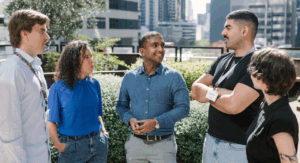
Measuring the ‘S’ in ESG
The ‘social’ in ESG has always been less well defined than the ‘environmental’. With SVA’s help, Australian Unity has for the first time developed a framework to define, measure and value the community and social impact it creates in its diverse businesses.
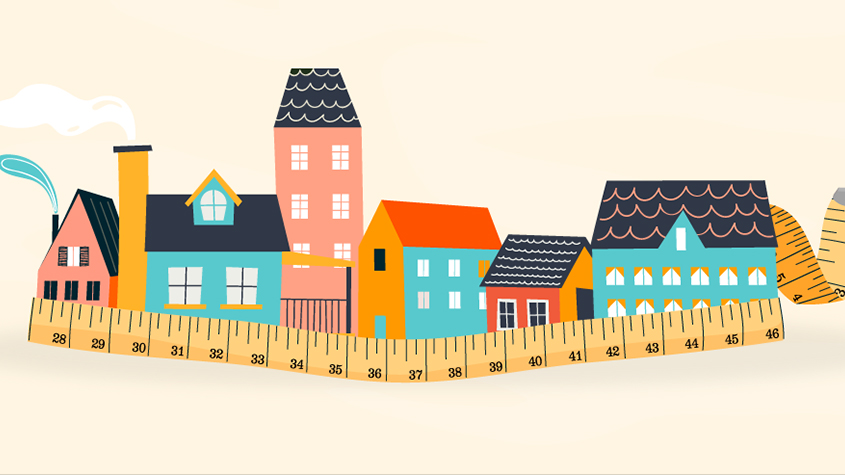
Across the corporate sector, the social or ‘S’ in environmental, social, governance (ESG)1 has not received the same attention, nor has it been as well described, as the ‘E’. Working alongside SVA, Australian Unity has developed a framework that allows them to define, measure and value their own ‘S’ through considering their contribution towards creating community and social value.
As a mutual, Australian Unity’s primary focus is designing and delivering products and services that benefit the wellbeing of its members however, it was no small task given the size and diversity of the organisation. Through this journey with SVA, Australian Unity has demonstrated how prioritising the creation of community and social value can complement financial growth. This has since led to discussions among other organisations about their own impact and how they can embed measurement of their ‘S’ or social impact.
Australian Unity and the motivator to measure the ‘S’
Australian Unity was established 180 years ago by a small group of community leaders to look after the health and wellbeing of its members.
Today, Australian Unity is still a member-based organisation with the same focus. It delivers on this mission through providing a variety of products and services which have positive social impact for its members and communities. This includes operating aged care and residential facilities, investing in social infrastructure including Specialist Disability Accommodation and providing investment products to help people achieve financial wellbeing and save for retirement.

… but we are also a member organisation so a lot of the measures for success exist outside the financial realm.”

This long-standing focus has guided Australian Unity’s growth over its history. As Rohan Mead, Group Managing Director explains “We are a commercial organisation, so commercial sustainability has always been a factor, but we are also a member organisation so a lot of the measures for success exist outside the financial realm; they exist with, and for, the individual policy holder (having a mild versus severe episode of mental illness for example) or in the community (having a high productivity due to more effective and faster rehab)”.
Given this, Australian Unity knew that any consideration of its own social impact needed to be centred around its communities. And so when referring to its impact, it calls it ‘community and social impact’ rather than simply social impact.
Australian Unity had also invested over 20 years in the delivery of the Australian Unity Wellbeing Index in partnership with Deakin University. The study and resulting evidence-base provides insights into the wellbeing of people across Australia and is helping to create a comprehensive and accepted definition of what wellbeing looks like. The study includes an annual national survey to measure subjective life quality conducted in partnership with the Australian Centre on Quality of Life.2
However over this time, Australian Unity had not fully described how the various components of the group came together to create outcomes for its communities. Nor did the group have an evidence-base that could demonstrate the contribution it made as a business to the individuals and communities it supported.
Further, the sectors in which Australian Unity operates across are changing. There are growing pools of capital available from investors keen to support initiatives that have demonstrable social impact—and just as many organisations putting their hand up to receive support. Australian Unity recognised that tapping into these funding pools would be pivotal to help them grow as an organisation.
To do this, they needed to demonstrate how their investments, products and services were contributing to community wellbeing. This required a robust framework that they could share publicly to demonstrate how their varied business units all contribute towards creating community and social value. When installed, the framework and measurement could also then be used internally, to drive better decision making and accelerate the business in areas where it could be shown it mattered most.
Internal discussions about how to define and measure impact had been going on for some years before Australian Unity engaged with the consulting arm of SVA in 2019. Importantly, this continued push to focus on impact was led by Mead, and Esther Kerr-Smith, CEO for Australian Unity’s Wealth and Capital Markets business.
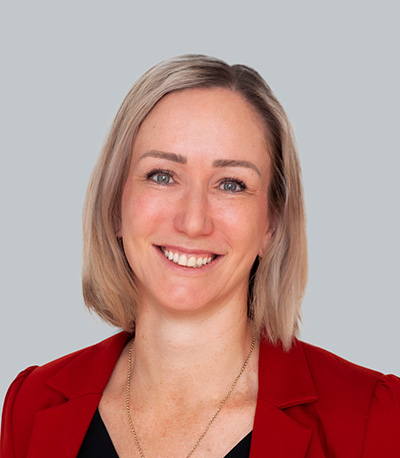
Both of them firmly believed there was huge benefit in measuring their community and social value as it would allow the group to capture the essence and value of a member-based organisation that financial and accounting standards were not able to do.

To get to the required transformation point across the organisation, we needed a framework that was more rigorous… and was more tailored to the nature of our business.”
After a year of researching potential social impact measures and frameworks, Kerr-Smith says that the group realised it could not use something off-the-shelf. “We needed to develop a framework from first principles. To get to the required transformation point across the organisation, we needed a framework that was more rigorous than the market’s early attempts at reporting ‘S’ and was more tailored to the nature of our business.”

Belinda Seal, General Manager of Group Strategy at Australian Unity, was tasked with turning an intangible opportunity into something real. In 2019, Seal brought SVA on to help articulate what a final framework could look like and to turn this vision into reality.
The first challenge was introducing the concept of outcomes (or changes for individuals) in a way that was relevant to people’s work – regardless of whether they worked on property developments, delivering care or providing health insurance. Kerr-Smith acknowledges this challenge, noting that there were only a few people across the organisation who really understood the potential of measuring social and community change.
This was a new way of thinking for many so building engagement and support was difficult, with a level of apprehension across some teams. Seal observed that “some leaders thought their businesses would be scored or compared against other business units, while others couldn’t see how it would apply to their work.”
“The approach we took wasn’t a specific market approach; nor a specific accounting strategy so people were finding it difficult to see how it would be useful,” says Seal.
For SVA, this engagement from across business units was important to ensure the work reflected an accurate picture of the entire organisation. The end vision was a group-level outcomes framework that was able to demonstrate a holistic picture of value creation and SVA was aware that to achieve this, it needed input from all teams.
The second challenge was to cut through the complexity that resulted from a diverse organisation with approximately 90 products and services across 14 business units. Ensuring each area was represented and incorporated into the outcomes framework and aligned with Australian Unity’s seven domains of wellbeing, as defined in their Wellbeing Index, was complex and required ongoing consultation and testing. This included several meetings with the leadership teams of each business unit across sectors to clearly explain the vision, work through how it aligned with their work and demonstrate how it might be used in the future.
This design phase took approximately six months to complete and resulted in a first draft of what would become known as the group’s ‘Community and Social Value (CSV) framework’. While this initial attempt reflected all elements of the business, in hindsight, the work resulted in a complex set of outcomes and measures that did not lead to the buy-in or simplicity that Australian Unity had anticipated.

… it was the first time we had seen a framework that had taken all the questions, challenges and complexities… and developed that into something tangible that we could work with…”
However, as Kerr-Smith recalls, while this first phase of building the framework was not perfect, it was the first breakthrough. “The framework gave us a methodology we could work on. It was grounded in logic, internally consistent, and it was the first time we had seen a framework that had taken all the questions, challenges and complexities of our organisation and developed that into something tangible that we could work with and respond to.”
This first phase was the starting point they needed to keep the work moving.
Further refine, measure and value
The level of effort and depth gone to, to understand the business and develop the framework up front, allowed Australian Unity to clearly articulate how it might be creating community and social value through a defined set of outcomes and this led to better engagement across teams.
This framework was further supported by Kerr-Smith’s willingness to start testing the emerging hypothesis that the ‘S’ in ESG could equal ‘wellbeing’ for Australian Unity. She investigated this in presentations to investors near the end of 2019, even though the framework was not finalised and received positive feedback from key stakeholders and investors. This contributed to the growing momentum around the work.
Within Australian Unity, the executive team had become accustomed to talking about the outcomes in the draft framework as concepts and some business units had begun using these to inform decisions, but the framework was still very complex and buy-in was slow.
Further, areas were not sharing the framework with partners, or with the public. The group’s executives realised they needed to go further than just articulating the outcomes in narrative form and instead had to find ways to prove their impact through measuring and valuing these outcomes. This also presented them with an opportunity to show the members, customers and the communities that Australian Unity supports that, as a mutual, it is different from other organisations.

… we needed to hold ourselves accountable and the impact report did this.”
SVA was engaged for a second time in 2021 to help measure the outcomes defined in the draft CSV framework and to place a financial value against each outcome. This engagement supported Australian Unity to define its impact through a social value lens, that considered financial proxies, counterfactuals and contribution (amongst other variables)3. As work in this space matured, the group committed to publishing their first stand-alone impact report as a way to share their CSV framework, and the resulting measures and values with the broader sector.
This commitment was crucial to driving the work forward as the group now had a deadline. As Seal explains, “we needed to give this thing some accelerant, we needed to hold ourselves accountable and the impact report did this.”
Taking on board the lessons from the previous phase, SVA’s first step was to revisit the outcomes originally listed under the three areas of impact. Based on conversations and workshops with the different business units, we looked at where they were having the most impact for members and customers and landed on six priority outcomes that were sufficiently broad to encompass the original outcomes. (See Figure 1.)
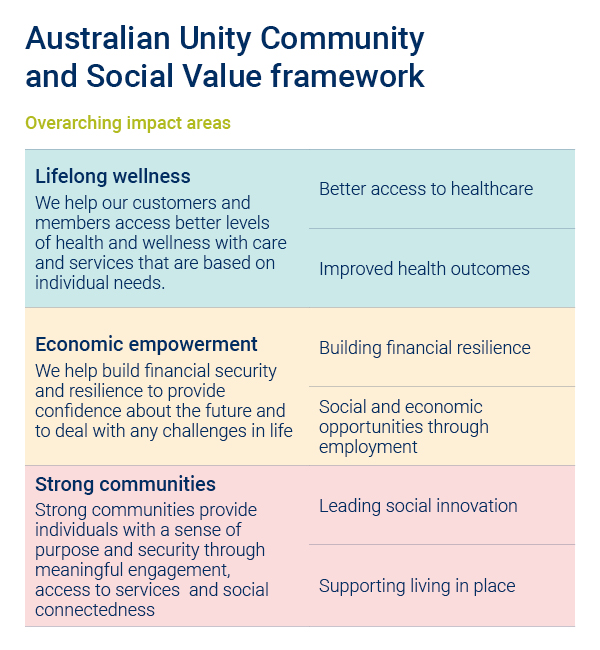
This simplification was a crucial step in enabling SVA to begin measuring and valuing how each product and service contributed to the outcomes.
Understanding the multitude of products and service offerings and how these could be measured required considerable consultation across the organisation. This time, however, the purpose was different. We needed to ensure the business units not only understood the process but that they remained focused on only measuring their material impact and not over claiming what value they were creating. This meant ensuring that we only captured the unique value that was being created through Australian Unity’s different products and services. A set of principles were established to guide this work, informed by the Social Value principles4 and adapted to fit the unique needs of the organisation. (See box, Principles.)
As Mead observes “having a sobering, realistic partnership [with SVA] was important to ensure that we remained true to our principles and kept ourselves honest”.
The next step, which was the most significant undertaking, was to identify indicators for each product and service to measure the six outcomes. The varied offerings across the 14 business units added a layer of complexity that required considerable time to resolve, spanning another eight-month period. This involved understanding the nuance of each business unit and the data available, to determine which products and services contributed to which specific outcomes, and to what extent.
In the end, we landed on a framework structured around the six outcomes and identified 193 indicators linked to these outcomes which allowed us to measure the combined impact of Australian Unity’s work.
For each indicator, we then developed a methodology to help us calculate the financial value – this included in depth research to identify appropriate financial proxies to inform the methodology and then applying a discount to each indicator’s value so that we could stay true to the principles we had developed.
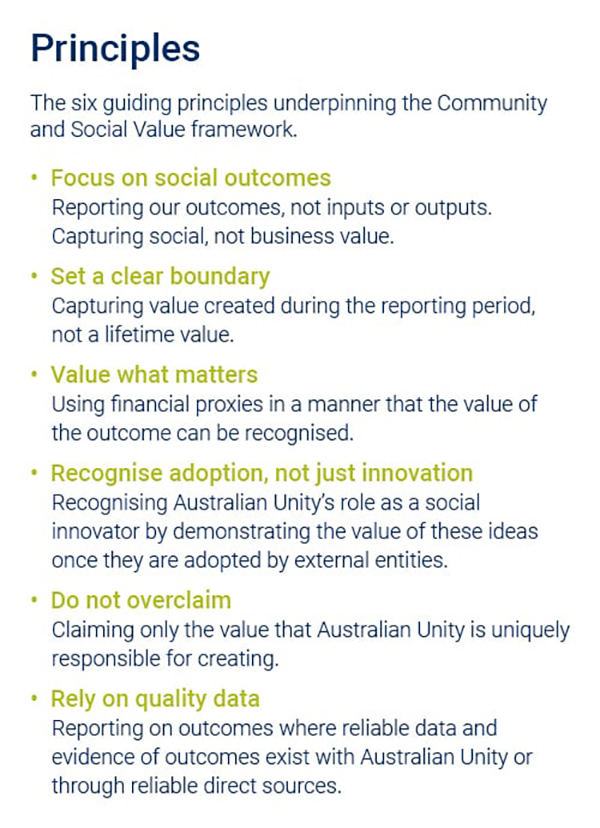
For example, if a product was not unique in the market, or the business unit was not solely responsible for the activity, we would discount the value appropriately to avoid overclaiming. In the end, this required us to collect over 300 data points from across Australian Unity’s business units, not including the external sources used to inform the financial proxies.
This work led to what Kerr-Smith recalls as the second ‘major breakthrough’ – being able to put a value to their impact.

Each of these calculations contributed to a total community and social impact value of $1.25 billion for the 2021 financial year (see Figure 2) and enabled Australian Unity to demonstrate for the first time, the positive community and social value they believed they were creating. This value did not take into consideration the size of the investment made to arrive at this value, so the work is not an investment analysis.
However as Kerr-Smith notes, “for the first time the impact valuation enabled us to bring everything together. It wasn’t perfect but we were brave enough to put something down on paper. This could become the language and framework that others in the sector can use.” Australian Unity now had a way to define its ‘S’.
Australian Unity’s Our Impact report was published late 2021.
Seal recalls that it was at this point that the work began gaining traction across the organisation. “The Our Impact report was the real momentum; once that had happened it took off, it was easier for people to see what the end product was.”
Getting the right people on board
Throughout the two projects, it was critical to engage the right people across the Australian Unity business, at the right time. The executives across business units needed to believe in the importance of outcomes measurement and understand the value for their teams for the work to be prioritised.
Having support from across the executive leadership team, the backing of the group’s board and, importantly, the backing of the Group Managing Director meant that Seal and her team were able to continuously reinforce the message with people in different forums. This ensured the right people were on board and understood the benefits of outcomes measurement. They were able to assemble ‘champions’ from across the organisation to advocate for and push this work forward. And SVA, working alongside them, were able to tap into the collective brainpower from people across the teams to input into the design of often complex methodologies to make sure they were right.
Australian Unity’s perspective
Mead is excited about how the framework will evolve and how it can be used as a set of dynamic measures to inform future planning. He says “we have set ourselves the audacious goal of returning our organisation to the sense of relevance to the community that it had in the 1800s. We are rethinking the role of mutuals in our communities through leveraging innovations such as impact investing and virtual health to regenerate our business model and demonstrate our value to communities.”
He believes that the CSV framework and their willingness to share their work, through their impact report, was a first step forward in this journey. “The report allows us to clearly articulate what our role is in the communities we support, to use it to inform investment decisions and opens us up to multiple new and innovative opportunities.”

… it will enable us to consider each decision through a community value lens and remain focused on the holistic impact of our portfolio.”
As a commercial organisation, Australian Unity recognises that not all decisions they take as a group will have a direct link to creating more community and social value. However as Seal points out, “it will enable us to consider each decision through a community value lens and remain focused on the holistic impact of our portfolio.”
“For example, being able to demonstrate to investors our commitment to creating social change, and back this up with evidence creates opportunities to raise more capital.”
This also applies to reinvesting this capital in such a way that will create impact, at-scale, in the longer-term. As Seal puts it “the more money we can make in a sustainable way the more impact we can have”.
From the perspective of the sector
The strength of the reaction across the sector was something that surprised Mead and Kerr-Smith.
ESG has been on the agenda in the corporate world for some time but with most of the emphasis on the ‘E’ rather than the ‘S’ and ‘G’. As Mead observes, the financial sector in particular was excited about the report as it has added to the thinking about the ‘S’ domain.
For Kerr-Smith, positioning ‘S’ as being equal to ‘wellbeing’ has made an important contribution to how to measure ‘S’ for businesses grappling with the same questions. The Business Council of Co-operatives and Mutuals have indicated their support for it and Kerr-Smith hopes that this might become a shared language, and baseline for other cooperatives and mutual enterprises to engage on ‘S’.
In the longer-term, having a set of metrics accepted as wellbeing measures provides Australian Unity with an evidence-base to demonstrate its community and social impact and will help them seek and mobilise capital at scale from a wider group of investors.
Australian Unity received recognition for its work in early July 2022 when it was awarded the Australian Financial Review’s specialist award, ‘the ESG Metrics Innovator award’ for developing a social value impact measurement framework.

… the work demonstrates that business complexity is not an impediment to social impact measurement…”
For SVA, the CSV framework is far from perfect and we have already started working with Australian Unity to further refine its measures in preparation for its second impact report. The CSV framework, however, has provided Australian Unity with a new way to think about the holistic contributions they make to the communities they serve and a way to articulate what wellbeing means for them and their members.
Overall, the work demonstrates that business complexity is not an impediment to social impact measurement and that business decisions can be informed by both financial and non-financial factors in a complementary way that can support growth.
Authors: Gillian Turnbull and Annabel Downing
- Environmental, Social, and Governance Evaluation, S&P Global, 2020
- Australian Centre on Quality of Life
- For more information on social value, see Social Value International website
- The Principles of Social Value, Social Value International website







